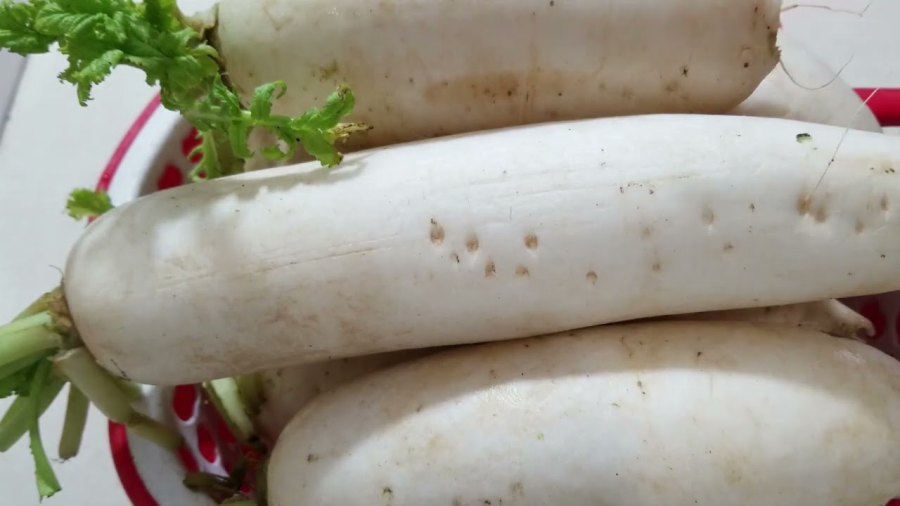White radish, one of the common vegetable sources, belongs to the group of low-calorie vegetables with surprisingly high nutritional content. According to estimations from nutritionists, 338 grams of fresh radish contains the following nutrients:
Calories: 61
Carbs: 14 grams
Protein: 2 grams
Fiber: 5 grams
Vitamin C: 124% DV
Folic acid (vitamin B9): 24% DV
Calcium: 9% DV
Magnesium: 14% DV
Potassium: 22% DV
Copper: 19% DV
DV (daily value): recommended daily dietary intake.
In addition, consuming white radish will also provide glucose, fructose, sucrose, Vitamin A, B, folate, choline… Traditional Chinese Medicine considers radish to have a sweet, slightly spicy, bitter taste with neutral temperament and non-toxic properties.

Benefits of white radish
Reducing the risk of cancer
Radish contains phytochemicals and anthocyanins, which have anti-cancer properties. It is also a good source of vitamin C, acting as a powerful antioxidant to prevent damage from free radicals to the DNA inside cells, thus helping to prevent cancer. Blood pressure regulation: It is a potassium-rich food that helps maintain the sodium-potassium balance in the body, thus keeping blood pressure stable. A study on nutrition and practice showed that radish leaves have a “hypotensive” effect in people with significant hypertension.
Preventing cold and cough
If you often suffer from cough and cold, adding radish to your diet can be a good idea to prevent these conditions. It is one of the vegetables that can relieve congestion and promote the production of mucus in your throat. In addition, radish also helps boost the immune system, keeping the body protected from infections that cause cold and cough.
Anemia prevention, brain health
The natural vitamin B12 in white radish helps promote iron absorption and participate in the synthesis of hemoglobin in the blood. Increased oxygen levels in hemoglobin help improve physical fitness and prevent anemia. Moreover, a study at Wake Forest University has shown that the high nitrate content in white radish can increase blood flow to the brain, improve cognitive function, enhance brain health, and even protect brain cells for many years.
Supporting liver and lung function, preventing cardiovascular disease and jaundice
Betaine, a nutrient found in white radish, supports liver function and reduces serum homocysteine – a factor that causes cardiovascular disease. With its detoxifying effect, white radish also helps cleanse the liver and stomach. In addition, white radish will assist you in controlling jaundice by regulating the amount of bilirubin in the blood and increasing oxygen levels in the body.
For asthma patients, the anti-congestive property of white radish is considered a golden characteristic. Furthermore, some studies have also suggested that white radish provides the ability to combat respiratory antigens, thereby protecting the soft lining inside this organ from infections.

Supporting digestion, preventing hemorrhoids
Like other fiber-rich plants, white radish has a laxative effect, enhancing intestinal activity. With lignin content (a carbohydrate structure molecule that is insoluble and difficult to digest), eating white radish creates conditions for the digestive system to retain water and reduce constipation, one of the main causes of hemorrhoids. Furthermore, white radish also promotes the body’s production of bile – one of the most important factors for digestive health and efficient functioning.
People who should avoid eating radish
According to experts, although radish is good for health, the two groups of people below are advised not to eat radish.
Individuals with digestive discomfort
People with digestive problems have relatively thin gastric mucosa. Although radish contains a lot of water and has a moisturizing effect on the intestines, its spicy taste can stimulate the gastric mucosa, causing certain damage to our intestines and stomach. Those with gastric problems should eat as little radish as possible, especially raw radish.
Individuals with weak constitutions
Individuals with weak constitutions may experience diarrhea when consuming cold foods. Eating radishes can easily cause diarrhea and discomfort in the digestive system, which is not good for health.
Therefore, these two types of people should eat less radish in winter. Especially raw radish. If you want to eat radish, you can use it as a filling for dumplings or boil it well before consuming.
It produces liquids and relieves thirst, while moistening the lungs and reducing coughing. Absolutely do not consume raw radish to ensure body safety.
Above are the people who should avoid eating radish. If you belong to any of these groups, please stay away from radishes.




































